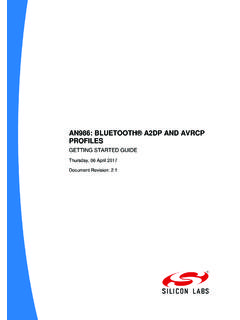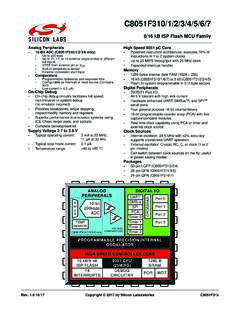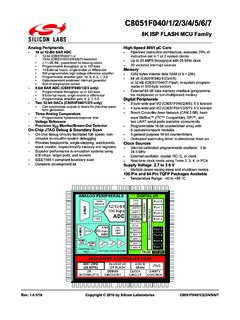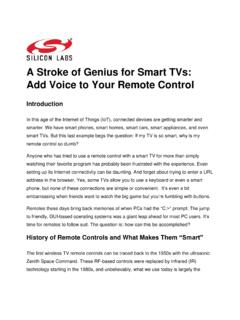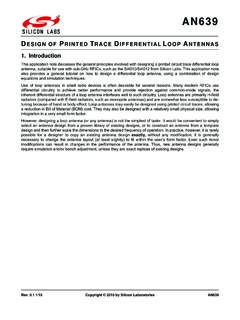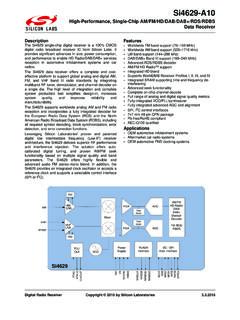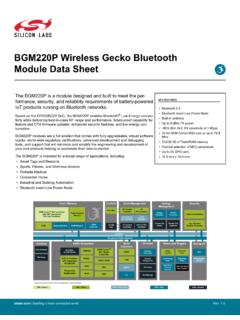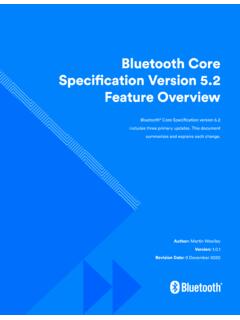Transcription of UG103.14: Bluetooth® LE Fundamentals - Silicon Labs
1 : bluetooth LE FundamentalsThis volume of Silicon Labs Fundamentals series provides anoverview of bluetooth low energy technology. Traditional Blue-tooth technology is optimized for sending a steady stream of highquality data in a power-efficient way. bluetooth low energy tech-nology allows for short bursts of long-range radio connections,making it ideal for applications that depend on long battery lifeand don t need high throughput streaming data. This overview fo-cuses on bluetooth low energy technology, but also calls outsome of the contrasts with traditional bluetooth Labs Fundamentals series covers topics that project managers, application de-signers, and developers should understand before beginning to work on an embeddednetworking solution using Silicon Labs chips, networking stacks such as EmberZNetPRO or Silicon Labs Thread, and associated development tools.
2 The documents canbe used as a starting place for anyone needing an introduction to developing wirelessnetworking applications, or who is new to the Silicon Labs development FEATURES Background Architecture Physical Layer Link Layer operations and networktopologies Generic Access Profile (GAP) Attribute Protocol (ATT) Generic Attribute Profile (GATT) Security | Building a more connected 1. BackgroundSilicon Labs is developing products designed to meet the demands of customers as we move to an ever-connected world of devices inthe home, what is often referred to as the IoT (Internet of Things).
3 At a high level, the goals of IoT for Silicon Labs are to: Connect all the devices in the home with best-in-class networking, whether with Zigbee PRO, Thread, bluetooth low energy technol-ogy, or other emerging standards. Leverage the company s expertise in energy-friendly microcontrollers. Enhance established low-power, mixed-signal chips. Provide low-cost bridging to existing Ethernet and Wi-Fi devices. Enable cloud services and connectivity to smartphones and tablets that promote ease of use and a common user experience all of these goals will increase adoption rates and user acceptance for IoT devices in the Connected technology is a core component of the IoT.
4 bluetooth was designed to offer a wireless alternative to cable connections byexchanging data using radio transmissions. One of the most popular applications for bluetooth has been wireless audio. This uses aversion of bluetooth called BR/EDR (Bit Rate/Enhanced Data Rate) that is optimized for sending a steady stream of high quality data ina power-efficient version introduced bluetooth with low energy functionality. Developers are now able to create sensors that can run oncoin-cell batteries for months and even years. Some of these sensors are so efficient that the kinetic energy from flipping a switch canprovide operating power.
5 bluetooth low energy technology is inherently different from BR/EDR. BR/EDR establishes a relatively short-range, continuous wireless connection, which makes it ideal for uses such as streaming audio from a smartphone to a headset. Blue-tooth low energy technology allows for short bursts of long-range radio connections, making it ideal for IoT applications that depend onlong battery life. Furthermore, bluetooth low energy technology is built on an entirely new development framework using GATT (Gener-ic Attributes). GATT profiles describes a use case, roles, and general behaviors based on the GATT functionality.
6 These profiles allowdevelopers to quickly and easily develop applications to connect devices directly to applications running on smartphones, PCs, or devices can be either dual mode, supporting both BR/EDR and bluetooth low energy technology, or single mode, supportingBluetooth low energy technology well as ultra-low power and connectivity to smartphones, PCs, and tablets, other benefits of bluetooth low energy technology in-clude: Low cost Reliable and robust: AFH (Adaptive Frequency Hopping), retransmissions and 24-bit CRC (Cyclic Redundancy Checks) Secure: pairing, bonding, privacy, MITM (Man in the Middle) protection, and AES-128 encryption Supports rapid development: Standardized profiles to cover key use cases (HR, HID, Glucose, Proximity, etc.)
7 Profiles can be developed as applications, supporting fast deployment Vendor-specific profiles omit the need to wait for bluetooth SIG to standardize profiles and operating system developers to inte-grate them Widely deployable: Supported by major platforms - iOS, Android and newer, Windows 8 and 10, OSX, and LinuxThe bluetooth specification is managed by the bluetooth SIG (special interest group). The SIG maintains a website ( ) that contains both introductory information and links to specifications and other more technical details. In this document, re-visions of the specification are referred to parenthetically, where ( ) means version of the document provides an overview of the following aspects of bluetooth low energy: bluetooth architecture overview Radio features Basic of link layer Explanation of how device discovery and connections work bluetooth security overview The Attribute Protocol The Generic Attribute Profile (GATT) and bluetooth : bluetooth LE | Building a more connected | 22.
8 bluetooth Low Energy ArchitectureThe bluetooth low energy architecture is illustrated in the following figure:Figure bluetooth Low Energy ArchitectureThe components are as follows: Physical layer: Controls radio transmission/receiving. Link Layer: Defines packet structure, includes the state machine and radio control, and provides link layer-level two layers are often grouped into a Controller, with the remaining layers grouped into a host. A Host-to-Controller interface (HCI)standardizes communication between the controller and the host.
9 The host layers are: L2 CAP: Logical Link Control and Adaptation Protocol. L2 CAP acts as a protocol multiplexer and handles segmentation and reas-sembly of packets. It also provides logical channels, which are multiplexed over one or more logical links. The L2 CAP used in Blue-tooth low energy technology is an optimized and simplified protocol based on the classic bluetooth L2 CAP. Typically, applicationdevelopers do not need to care about the details of interacting with the L2 CAP layer. The interaction is handled by the Bluetoothstack, and the details of the L2 CAP operation are not covered in this document.
10 ATT: Attribute Protocol. The attribute protocol provides means to transmit data between bluetooth low energy devices. It relies on aBluetooth low energy connection and provides procedures to read, write, indicate, and notify attribute values over that is used in most bluetooth low energy applications and occasionally in BR/EDR applications. GATT: Generic Attribute Profile. The GATT is used to group individual attributes into logical services, for example the Heart RateService, which exposes the operation of a heart rate sensor. In addition to the actual data, the GATT also provides information aboutthe attributes, that is, how they can be accessed and what security level is needed.
